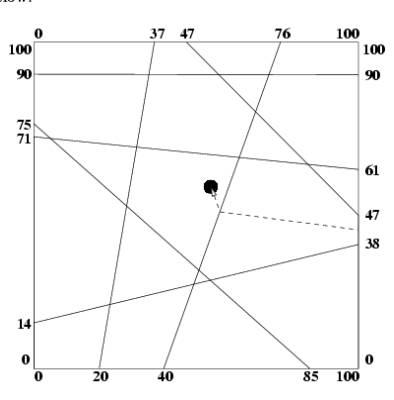题目链接:POJ 1066
Description
Archeologists from the Antiquities and Curios Museum (ACM) have flown to Egypt to examine the great pyramid of Key-Ops. Using state-of-the-art technology they are able to determine that the lower floor of the pyramid is constructed from a series of straightline walls, which intersect to form numerous enclosed chambers.
Currently, no doors exist to allow access to any chamber. This state-of-the-art technology has also pinpointed the location of the treasure room. What these dedicated (and greedy) archeologists want to do is blast doors through the walls to get to the treasure room. However, to minimize the damage to the artwork in the intervening chambers (and stay under their government grant for dynamite) they want to blast through the minimum number of doors. For structural integrity purposes, doors should only be blasted at the midpoint of the wall of the room being entered. You are to write a program which determines this minimum number of doors.
An example is shown below:
Input
The input will consist of one case. The first line will be an integer n (0 <= n <= 30) specifying number of interior walls, followed by n lines containing integer endpoints of each wall x1 y1 x2 y2 . The 4 enclosing walls of the pyramid have fixed endpoints at (0,0); (0,100); (100,100) and (100,0) and are not included in the list of walls. The interior walls always span from one exterior wall to another exterior wall and are arranged such that no more than two walls intersect at any point. You may assume that no two given walls coincide. After the listing of the interior walls there will be one final line containing the floating point coordinates of the treasure in the treasure room (guaranteed not to lie on a wall).
Output
Print a single line listing the minimum number of doors which need to be created, in the format shown below.
Sample Input
1 | 7 |
Sample Output
1 | Number of doors = 2 |
Source
East Central North America 1999
Solution
题意
给定 $n$ 条线段,代表围墙,最外层为 $100 \times 100$ 的正方形围墙。给定宝藏的坐标,求从外面进去拿到宝藏最少要穿过几堵墙。
思路
枚举正方形边上的所有端点与宝藏构成的线段,与多少堵墙相交,相交最少的即为答案。
线段 $A$ 与线段 $B$ 相交的判断:$A$ 的两个端点在线段 $B$ 的两边且线段 $B$ 的两个端点在线段 $A$ 的两边。
Code
1 |
|
